The Impact of Study Skills on Learning: A Comprehensive Analysis
VerifiedAdded on 2023/06/18
|27
|5600
|262
Essay
AI Summary
This essay outlines the significance of study skills in enhancing learning and development. It defines study skills as abilities, habits, understandings, and attitudes that enable achievement in study, categorized into self, academic, people, and task-related areas. The essay emphasizes the importance of academic skills for boosting confidence and enabling effective work or study, highlighting self-management and time management as essential qualities. It discusses the need for autonomy in scrutinizing sources and the role of memory skills, while also underscoring that understanding material is more effective than mere memorization. The essay further explores the benefits of teamwork, task awareness, and the importance of practice and habit in achieving academic goals. It concludes that a combination of various study skills is necessary for success, with each skill complementing the others. The document is contributed by a student and is available on Desklib, a platform offering study tools and resources for students.
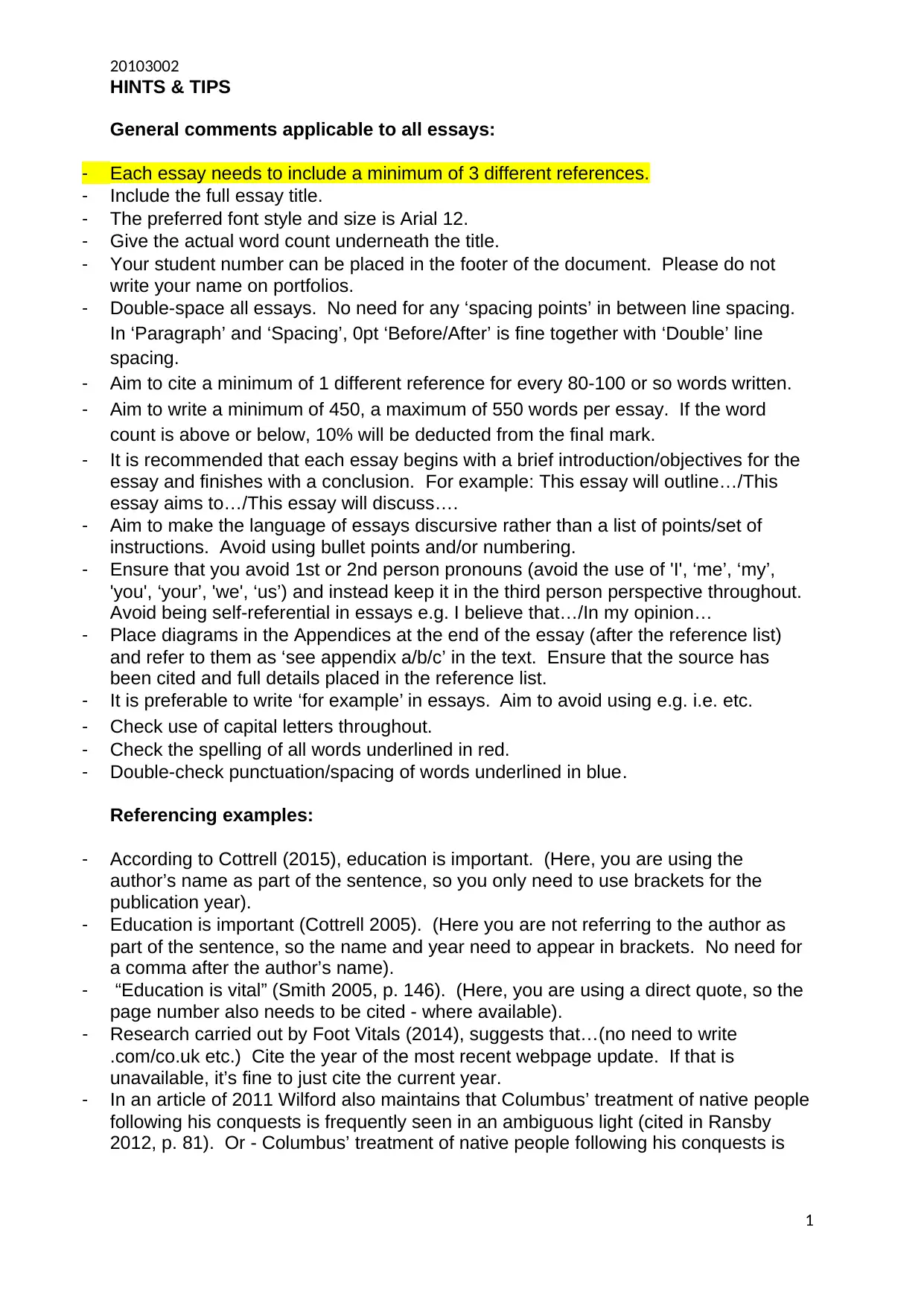
20103002
HINTS & TIPS
General comments applicable to all essays:
- Each essay needs to include a minimum of 3 different references.
- Include the full essay title.
- The preferred font style and size is Arial 12.
- Give the actual word count underneath the title.
- Your student number can be placed in the footer of the document. Please do not
write your name on portfolios.
- Double-space all essays. No need for any ‘spacing points’ in between line spacing.
In ‘Paragraph’ and ‘Spacing’, 0pt ‘Before/After’ is fine together with ‘Double’ line
spacing.
- Aim to cite a minimum of 1 different reference for every 80-100 or so words written.
- Aim to write a minimum of 450, a maximum of 550 words per essay. If the word
count is above or below, 10% will be deducted from the final mark.
- It is recommended that each essay begins with a brief introduction/objectives for the
essay and finishes with a conclusion. For example: This essay will outline…/This
essay aims to…/This essay will discuss….
- Aim to make the language of essays discursive rather than a list of points/set of
instructions. Avoid using bullet points and/or numbering.
- Ensure that you avoid 1st or 2nd person pronouns (avoid the use of 'I', ‘me’, ‘my’,
'you', ‘your’, 'we', ‘us’) and instead keep it in the third person perspective throughout.
Avoid being self-referential in essays e.g. I believe that…/In my opinion…
- Place diagrams in the Appendices at the end of the essay (after the reference list)
and refer to them as ‘see appendix a/b/c’ in the text. Ensure that the source has
been cited and full details placed in the reference list.
- It is preferable to write ‘for example’ in essays. Aim to avoid using e.g. i.e. etc.
- Check use of capital letters throughout.
- Check the spelling of all words underlined in red.
- Double-check punctuation/spacing of words underlined in blue.
Referencing examples:
- According to Cottrell (2015), education is important. (Here, you are using the
author’s name as part of the sentence, so you only need to use brackets for the
publication year).
- Education is important (Cottrell 2005). (Here you are not referring to the author as
part of the sentence, so the name and year need to appear in brackets. No need for
a comma after the author’s name).
- “Education is vital” (Smith 2005, p. 146). (Here, you are using a direct quote, so the
page number also needs to be cited - where available).
- Research carried out by Foot Vitals (2014), suggests that…(no need to write
.com/co.uk etc.) Cite the year of the most recent webpage update. If that is
unavailable, it’s fine to just cite the current year.
- In an article of 2011 Wilford also maintains that Columbus’ treatment of native people
following his conquests is frequently seen in an ambiguous light (cited in Ransby
2012, p. 81). Or - Columbus’ treatment of native people following his conquests is
1
HINTS & TIPS
General comments applicable to all essays:
- Each essay needs to include a minimum of 3 different references.
- Include the full essay title.
- The preferred font style and size is Arial 12.
- Give the actual word count underneath the title.
- Your student number can be placed in the footer of the document. Please do not
write your name on portfolios.
- Double-space all essays. No need for any ‘spacing points’ in between line spacing.
In ‘Paragraph’ and ‘Spacing’, 0pt ‘Before/After’ is fine together with ‘Double’ line
spacing.
- Aim to cite a minimum of 1 different reference for every 80-100 or so words written.
- Aim to write a minimum of 450, a maximum of 550 words per essay. If the word
count is above or below, 10% will be deducted from the final mark.
- It is recommended that each essay begins with a brief introduction/objectives for the
essay and finishes with a conclusion. For example: This essay will outline…/This
essay aims to…/This essay will discuss….
- Aim to make the language of essays discursive rather than a list of points/set of
instructions. Avoid using bullet points and/or numbering.
- Ensure that you avoid 1st or 2nd person pronouns (avoid the use of 'I', ‘me’, ‘my’,
'you', ‘your’, 'we', ‘us’) and instead keep it in the third person perspective throughout.
Avoid being self-referential in essays e.g. I believe that…/In my opinion…
- Place diagrams in the Appendices at the end of the essay (after the reference list)
and refer to them as ‘see appendix a/b/c’ in the text. Ensure that the source has
been cited and full details placed in the reference list.
- It is preferable to write ‘for example’ in essays. Aim to avoid using e.g. i.e. etc.
- Check use of capital letters throughout.
- Check the spelling of all words underlined in red.
- Double-check punctuation/spacing of words underlined in blue.
Referencing examples:
- According to Cottrell (2015), education is important. (Here, you are using the
author’s name as part of the sentence, so you only need to use brackets for the
publication year).
- Education is important (Cottrell 2005). (Here you are not referring to the author as
part of the sentence, so the name and year need to appear in brackets. No need for
a comma after the author’s name).
- “Education is vital” (Smith 2005, p. 146). (Here, you are using a direct quote, so the
page number also needs to be cited - where available).
- Research carried out by Foot Vitals (2014), suggests that…(no need to write
.com/co.uk etc.) Cite the year of the most recent webpage update. If that is
unavailable, it’s fine to just cite the current year.
- In an article of 2011 Wilford also maintains that Columbus’ treatment of native people
following his conquests is frequently seen in an ambiguous light (cited in Ransby
2012, p. 81). Or - Columbus’ treatment of native people following his conquests is
1
Paraphrase This Document
Need a fresh take? Get an instant paraphrase of this document with our AI Paraphraser
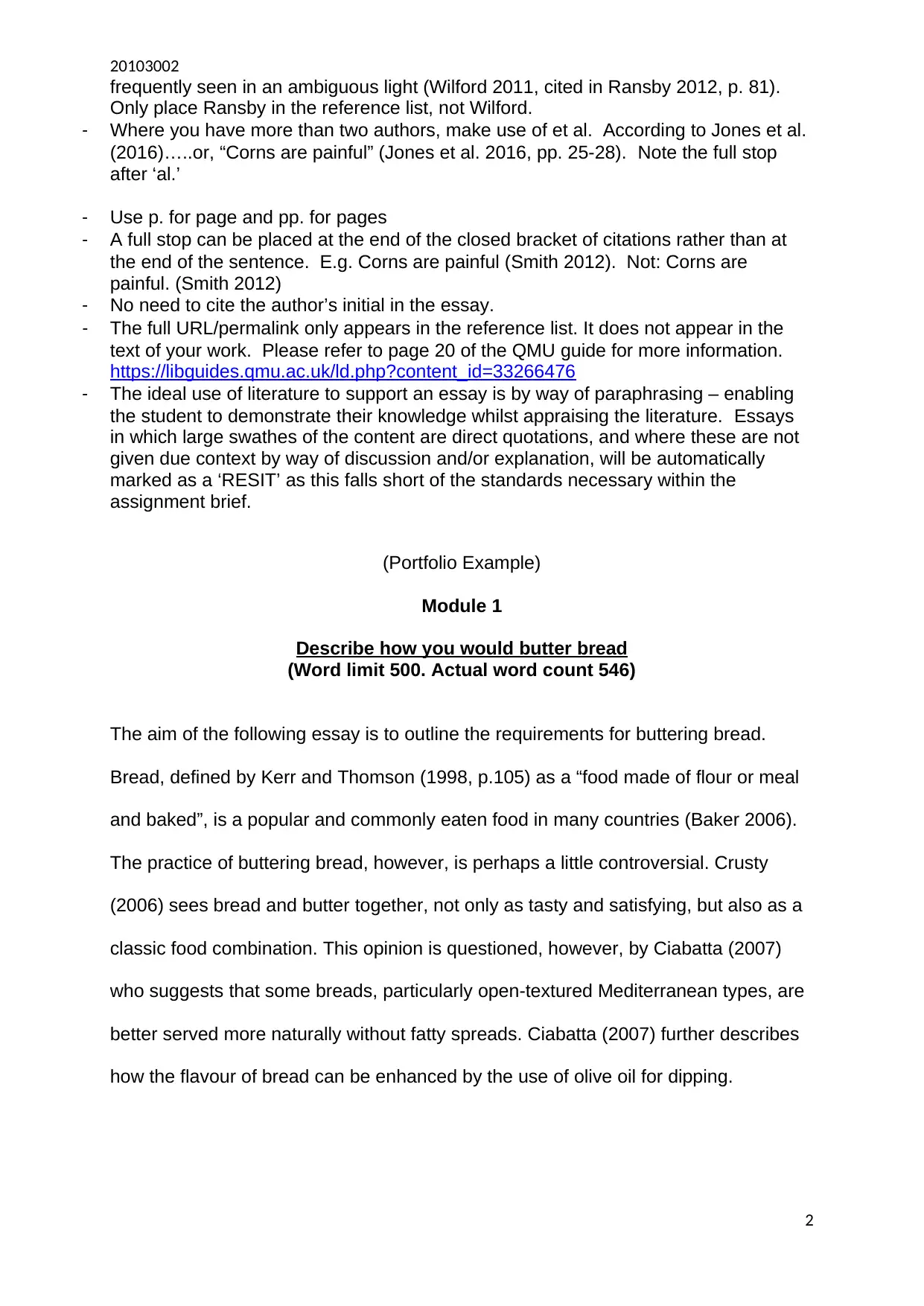
20103002
frequently seen in an ambiguous light (Wilford 2011, cited in Ransby 2012, p. 81).
Only place Ransby in the reference list, not Wilford.
- Where you have more than two authors, make use of et al. According to Jones et al.
(2016)…..or, “Corns are painful” (Jones et al. 2016, pp. 25-28). Note the full stop
after ‘al.’
- Use p. for page and pp. for pages
- A full stop can be placed at the end of the closed bracket of citations rather than at
the end of the sentence. E.g. Corns are painful (Smith 2012). Not: Corns are
painful. (Smith 2012)
- No need to cite the author’s initial in the essay.
- The full URL/permalink only appears in the reference list. It does not appear in the
text of your work. Please refer to page 20 of the QMU guide for more information.
https://libguides.qmu.ac.uk/ld.php?content_id=33266476
- The ideal use of literature to support an essay is by way of paraphrasing – enabling
the student to demonstrate their knowledge whilst appraising the literature. Essays
in which large swathes of the content are direct quotations, and where these are not
given due context by way of discussion and/or explanation, will be automatically
marked as a ‘RESIT’ as this falls short of the standards necessary within the
assignment brief.
(Portfolio Example)
Module 1
Describe how you would butter bread
(Word limit 500. Actual word count 546)
The aim of the following essay is to outline the requirements for buttering bread.
Bread, defined by Kerr and Thomson (1998, p.105) as a “food made of flour or meal
and baked”, is a popular and commonly eaten food in many countries (Baker 2006).
The practice of buttering bread, however, is perhaps a little controversial. Crusty
(2006) sees bread and butter together, not only as tasty and satisfying, but also as a
classic food combination. This opinion is questioned, however, by Ciabatta (2007)
who suggests that some breads, particularly open-textured Mediterranean types, are
better served more naturally without fatty spreads. Ciabatta (2007) further describes
how the flavour of bread can be enhanced by the use of olive oil for dipping.
2
frequently seen in an ambiguous light (Wilford 2011, cited in Ransby 2012, p. 81).
Only place Ransby in the reference list, not Wilford.
- Where you have more than two authors, make use of et al. According to Jones et al.
(2016)…..or, “Corns are painful” (Jones et al. 2016, pp. 25-28). Note the full stop
after ‘al.’
- Use p. for page and pp. for pages
- A full stop can be placed at the end of the closed bracket of citations rather than at
the end of the sentence. E.g. Corns are painful (Smith 2012). Not: Corns are
painful. (Smith 2012)
- No need to cite the author’s initial in the essay.
- The full URL/permalink only appears in the reference list. It does not appear in the
text of your work. Please refer to page 20 of the QMU guide for more information.
https://libguides.qmu.ac.uk/ld.php?content_id=33266476
- The ideal use of literature to support an essay is by way of paraphrasing – enabling
the student to demonstrate their knowledge whilst appraising the literature. Essays
in which large swathes of the content are direct quotations, and where these are not
given due context by way of discussion and/or explanation, will be automatically
marked as a ‘RESIT’ as this falls short of the standards necessary within the
assignment brief.
(Portfolio Example)
Module 1
Describe how you would butter bread
(Word limit 500. Actual word count 546)
The aim of the following essay is to outline the requirements for buttering bread.
Bread, defined by Kerr and Thomson (1998, p.105) as a “food made of flour or meal
and baked”, is a popular and commonly eaten food in many countries (Baker 2006).
The practice of buttering bread, however, is perhaps a little controversial. Crusty
(2006) sees bread and butter together, not only as tasty and satisfying, but also as a
classic food combination. This opinion is questioned, however, by Ciabatta (2007)
who suggests that some breads, particularly open-textured Mediterranean types, are
better served more naturally without fatty spreads. Ciabatta (2007) further describes
how the flavour of bread can be enhanced by the use of olive oil for dipping.
2
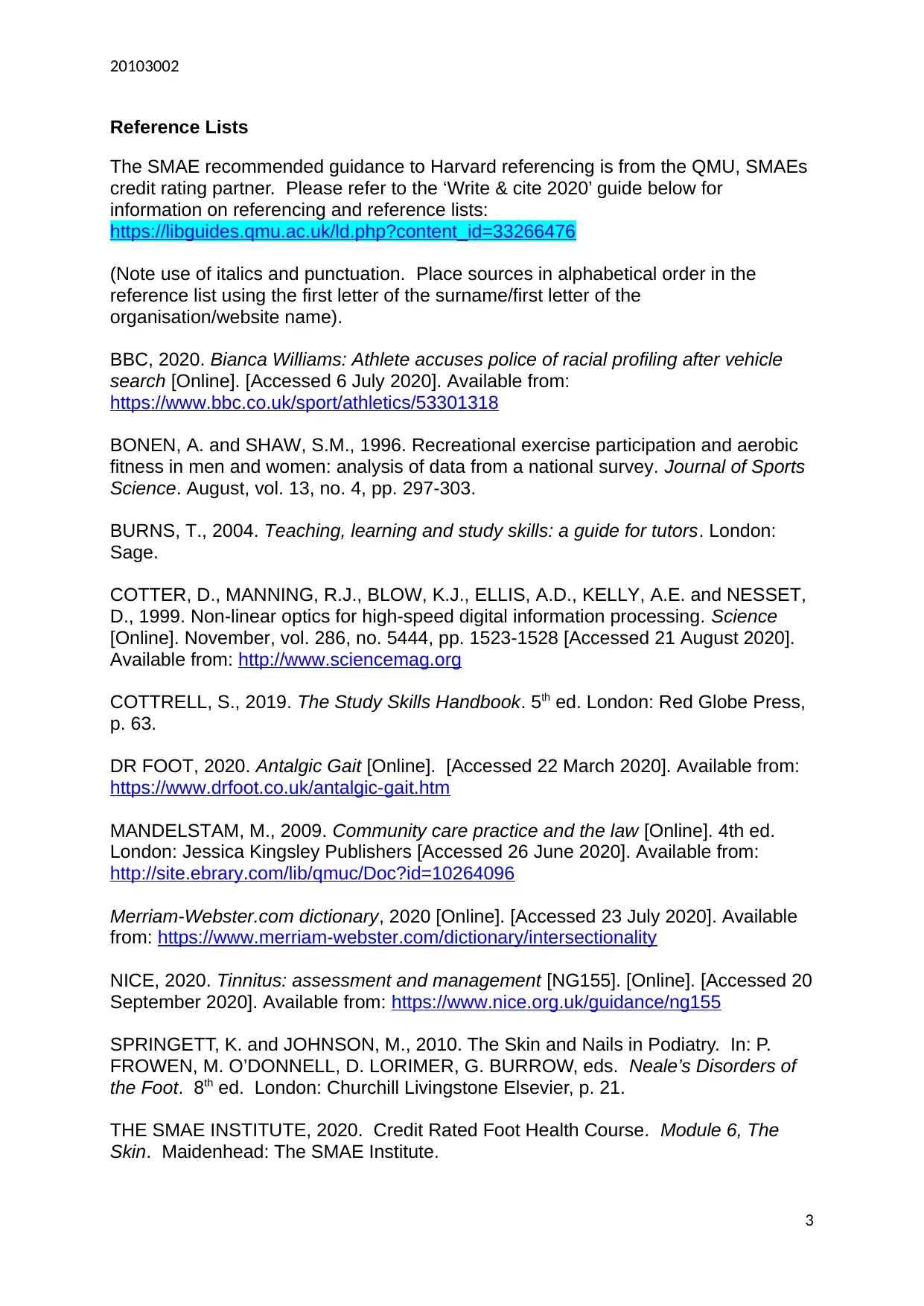
20103002
Reference Lists
The SMAE recommended guidance to Harvard referencing is from the QMU, SMAEs
credit rating partner. Please refer to the ‘Write & cite 2020’ guide below for
information on referencing and reference lists:
https://libguides.qmu.ac.uk/ld.php?content_id=33266476
(Note use of italics and punctuation. Place sources in alphabetical order in the
reference list using the first letter of the surname/first letter of the
organisation/website name).
BBC, 2020. Bianca Williams: Athlete accuses police of racial profiling after vehicle
search [Online]. [Accessed 6 July 2020]. Available from:
https://www.bbc.co.uk/sport/athletics/53301318
BONEN, A. and SHAW, S.M., 1996. Recreational exercise participation and aerobic
fitness in men and women: analysis of data from a national survey. Journal of Sports
Science. August, vol. 13, no. 4, pp. 297-303.
BURNS, T., 2004. Teaching, learning and study skills: a guide for tutors. London:
Sage.
COTTER, D., MANNING, R.J., BLOW, K.J., ELLIS, A.D., KELLY, A.E. and NESSET,
D., 1999. Non-linear optics for high-speed digital information processing. Science
[Online]. November, vol. 286, no. 5444, pp. 1523-1528 [Accessed 21 August 2020].
Available from: http://www.sciencemag.org
COTTRELL, S., 2019. The Study Skills Handbook. 5th ed. London: Red Globe Press,
p. 63.
DR FOOT, 2020. Antalgic Gait [Online]. [Accessed 22 March 2020]. Available from:
https://www.drfoot.co.uk/antalgic-gait.htm
MANDELSTAM, M., 2009. Community care practice and the law [Online]. 4th ed.
London: Jessica Kingsley Publishers [Accessed 26 June 2020]. Available from:
http://site.ebrary.com/lib/qmuc/Doc?id=10264096
Merriam-Webster.com dictionary, 2020 [Online]. [Accessed 23 July 2020]. Available
from: https://www.merriam-webster.com/dictionary/intersectionality
NICE, 2020. Tinnitus: assessment and management [NG155]. [Online]. [Accessed 20
September 2020]. Available from: https://www.nice.org.uk/guidance/ng155
SPRINGETT, K. and JOHNSON, M., 2010. The Skin and Nails in Podiatry. In: P.
FROWEN, M. O’DONNELL, D. LORIMER, G. BURROW, eds. Neale’s Disorders of
the Foot. 8th ed. London: Churchill Livingstone Elsevier, p. 21.
THE SMAE INSTITUTE, 2020. Credit Rated Foot Health Course. Module 6, The
Skin. Maidenhead: The SMAE Institute.
3
Reference Lists
The SMAE recommended guidance to Harvard referencing is from the QMU, SMAEs
credit rating partner. Please refer to the ‘Write & cite 2020’ guide below for
information on referencing and reference lists:
https://libguides.qmu.ac.uk/ld.php?content_id=33266476
(Note use of italics and punctuation. Place sources in alphabetical order in the
reference list using the first letter of the surname/first letter of the
organisation/website name).
BBC, 2020. Bianca Williams: Athlete accuses police of racial profiling after vehicle
search [Online]. [Accessed 6 July 2020]. Available from:
https://www.bbc.co.uk/sport/athletics/53301318
BONEN, A. and SHAW, S.M., 1996. Recreational exercise participation and aerobic
fitness in men and women: analysis of data from a national survey. Journal of Sports
Science. August, vol. 13, no. 4, pp. 297-303.
BURNS, T., 2004. Teaching, learning and study skills: a guide for tutors. London:
Sage.
COTTER, D., MANNING, R.J., BLOW, K.J., ELLIS, A.D., KELLY, A.E. and NESSET,
D., 1999. Non-linear optics for high-speed digital information processing. Science
[Online]. November, vol. 286, no. 5444, pp. 1523-1528 [Accessed 21 August 2020].
Available from: http://www.sciencemag.org
COTTRELL, S., 2019. The Study Skills Handbook. 5th ed. London: Red Globe Press,
p. 63.
DR FOOT, 2020. Antalgic Gait [Online]. [Accessed 22 March 2020]. Available from:
https://www.drfoot.co.uk/antalgic-gait.htm
MANDELSTAM, M., 2009. Community care practice and the law [Online]. 4th ed.
London: Jessica Kingsley Publishers [Accessed 26 June 2020]. Available from:
http://site.ebrary.com/lib/qmuc/Doc?id=10264096
Merriam-Webster.com dictionary, 2020 [Online]. [Accessed 23 July 2020]. Available
from: https://www.merriam-webster.com/dictionary/intersectionality
NICE, 2020. Tinnitus: assessment and management [NG155]. [Online]. [Accessed 20
September 2020]. Available from: https://www.nice.org.uk/guidance/ng155
SPRINGETT, K. and JOHNSON, M., 2010. The Skin and Nails in Podiatry. In: P.
FROWEN, M. O’DONNELL, D. LORIMER, G. BURROW, eds. Neale’s Disorders of
the Foot. 8th ed. London: Churchill Livingstone Elsevier, p. 21.
THE SMAE INSTITUTE, 2020. Credit Rated Foot Health Course. Module 6, The
Skin. Maidenhead: The SMAE Institute.
3
⊘ This is a preview!⊘
Do you want full access?
Subscribe today to unlock all pages.

Trusted by 1+ million students worldwide
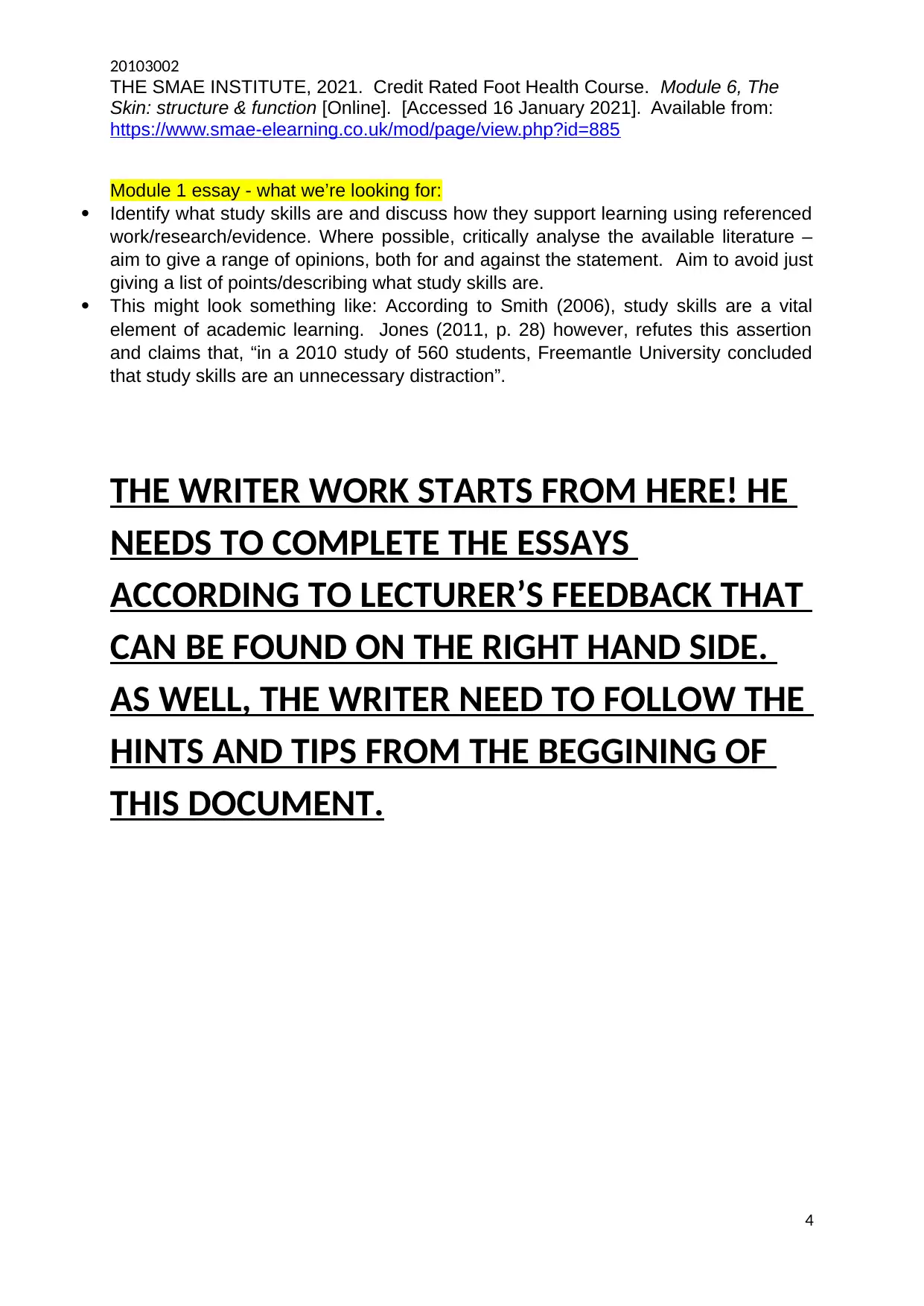
20103002
THE SMAE INSTITUTE, 2021. Credit Rated Foot Health Course. Module 6, The
Skin: structure & function [Online]. [Accessed 16 January 2021]. Available from:
https://www.smae-elearning.co.uk/mod/page/view.php?id=885
Module 1 essay - what we’re looking for:
Identify what study skills are and discuss how they support learning using referenced
work/research/evidence. Where possible, critically analyse the available literature –
aim to give a range of opinions, both for and against the statement. Aim to avoid just
giving a list of points/describing what study skills are.
This might look something like: According to Smith (2006), study skills are a vital
element of academic learning. Jones (2011, p. 28) however, refutes this assertion
and claims that, “in a 2010 study of 560 students, Freemantle University concluded
that study skills are an unnecessary distraction”.
THE WRITER WORK STARTS FROM HERE! HE
NEEDS TO COMPLETE THE ESSAYS
ACCORDING TO LECTURER’S FEEDBACK THAT
CAN BE FOUND ON THE RIGHT HAND SIDE.
AS WELL, THE WRITER NEED TO FOLLOW THE
HINTS AND TIPS FROM THE BEGGINING OF
THIS DOCUMENT.
4
THE SMAE INSTITUTE, 2021. Credit Rated Foot Health Course. Module 6, The
Skin: structure & function [Online]. [Accessed 16 January 2021]. Available from:
https://www.smae-elearning.co.uk/mod/page/view.php?id=885
Module 1 essay - what we’re looking for:
Identify what study skills are and discuss how they support learning using referenced
work/research/evidence. Where possible, critically analyse the available literature –
aim to give a range of opinions, both for and against the statement. Aim to avoid just
giving a list of points/describing what study skills are.
This might look something like: According to Smith (2006), study skills are a vital
element of academic learning. Jones (2011, p. 28) however, refutes this assertion
and claims that, “in a 2010 study of 560 students, Freemantle University concluded
that study skills are an unnecessary distraction”.
THE WRITER WORK STARTS FROM HERE! HE
NEEDS TO COMPLETE THE ESSAYS
ACCORDING TO LECTURER’S FEEDBACK THAT
CAN BE FOUND ON THE RIGHT HAND SIDE.
AS WELL, THE WRITER NEED TO FOLLOW THE
HINTS AND TIPS FROM THE BEGGINING OF
THIS DOCUMENT.
4
Paraphrase This Document
Need a fresh take? Get an instant paraphrase of this document with our AI Paraphraser
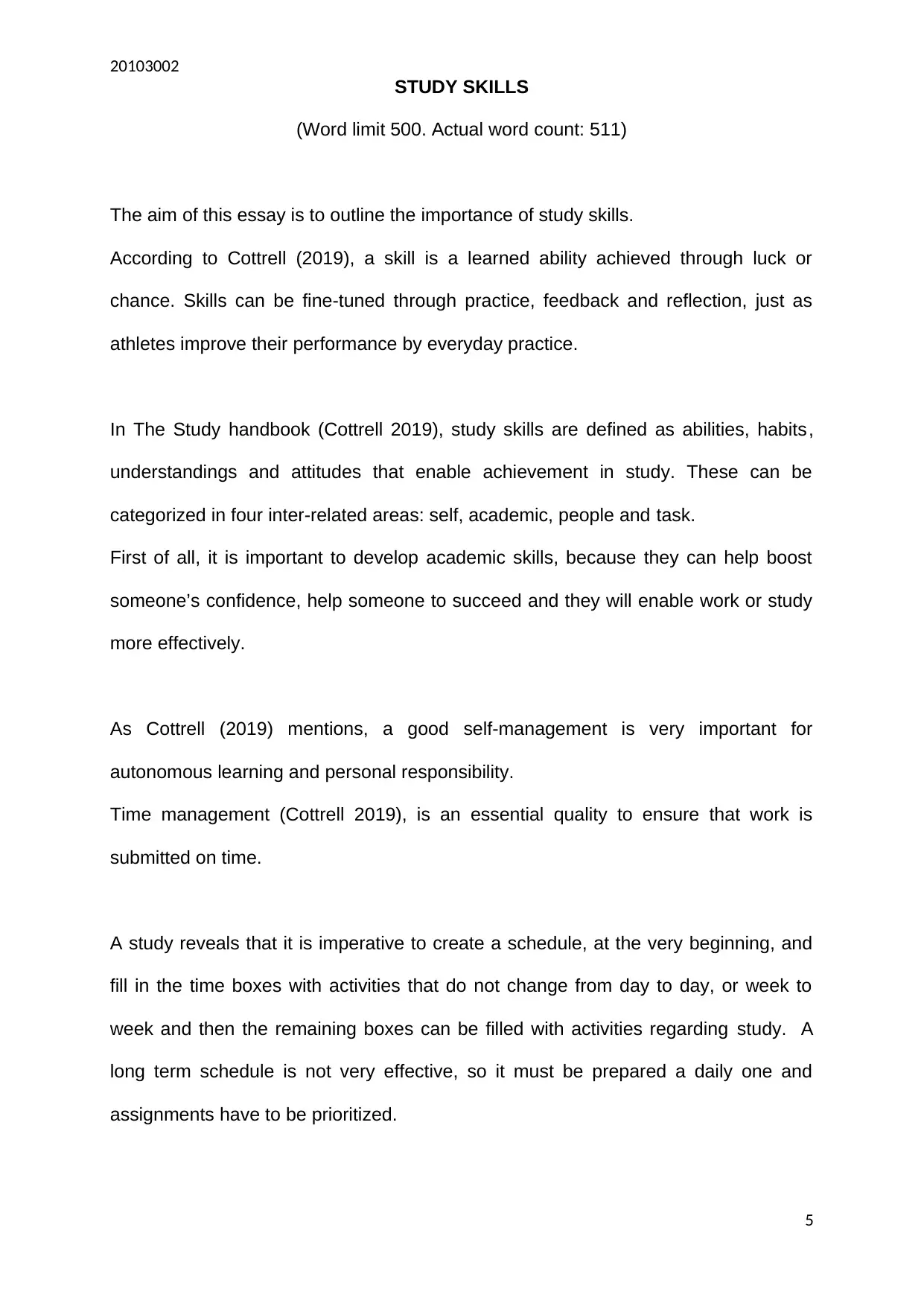
20103002
STUDY SKILLS
(Word limit 500. Actual word count: 511)
The aim of this essay is to outline the importance of study skills.
According to Cottrell (2019), a skill is a learned ability achieved through luck or
chance. Skills can be fine-tuned through practice, feedback and reflection, just as
athletes improve their performance by everyday practice.
In The Study handbook (Cottrell 2019), study skills are defined as abilities, habits,
understandings and attitudes that enable achievement in study. These can be
categorized in four inter-related areas: self, academic, people and task.
First of all, it is important to develop academic skills, because they can help boost
someone’s confidence, help someone to succeed and they will enable work or study
more effectively.
As Cottrell (2019) mentions, a good self-management is very important for
autonomous learning and personal responsibility.
Time management (Cottrell 2019), is an essential quality to ensure that work is
submitted on time.
A study reveals that it is imperative to create a schedule, at the very beginning, and
fill in the time boxes with activities that do not change from day to day, or week to
week and then the remaining boxes can be filled with activities regarding study. A
long term schedule is not very effective, so it must be prepared a daily one and
assignments have to be prioritized.
5
STUDY SKILLS
(Word limit 500. Actual word count: 511)
The aim of this essay is to outline the importance of study skills.
According to Cottrell (2019), a skill is a learned ability achieved through luck or
chance. Skills can be fine-tuned through practice, feedback and reflection, just as
athletes improve their performance by everyday practice.
In The Study handbook (Cottrell 2019), study skills are defined as abilities, habits,
understandings and attitudes that enable achievement in study. These can be
categorized in four inter-related areas: self, academic, people and task.
First of all, it is important to develop academic skills, because they can help boost
someone’s confidence, help someone to succeed and they will enable work or study
more effectively.
As Cottrell (2019) mentions, a good self-management is very important for
autonomous learning and personal responsibility.
Time management (Cottrell 2019), is an essential quality to ensure that work is
submitted on time.
A study reveals that it is imperative to create a schedule, at the very beginning, and
fill in the time boxes with activities that do not change from day to day, or week to
week and then the remaining boxes can be filled with activities regarding study. A
long term schedule is not very effective, so it must be prepared a daily one and
assignments have to be prioritized.
5
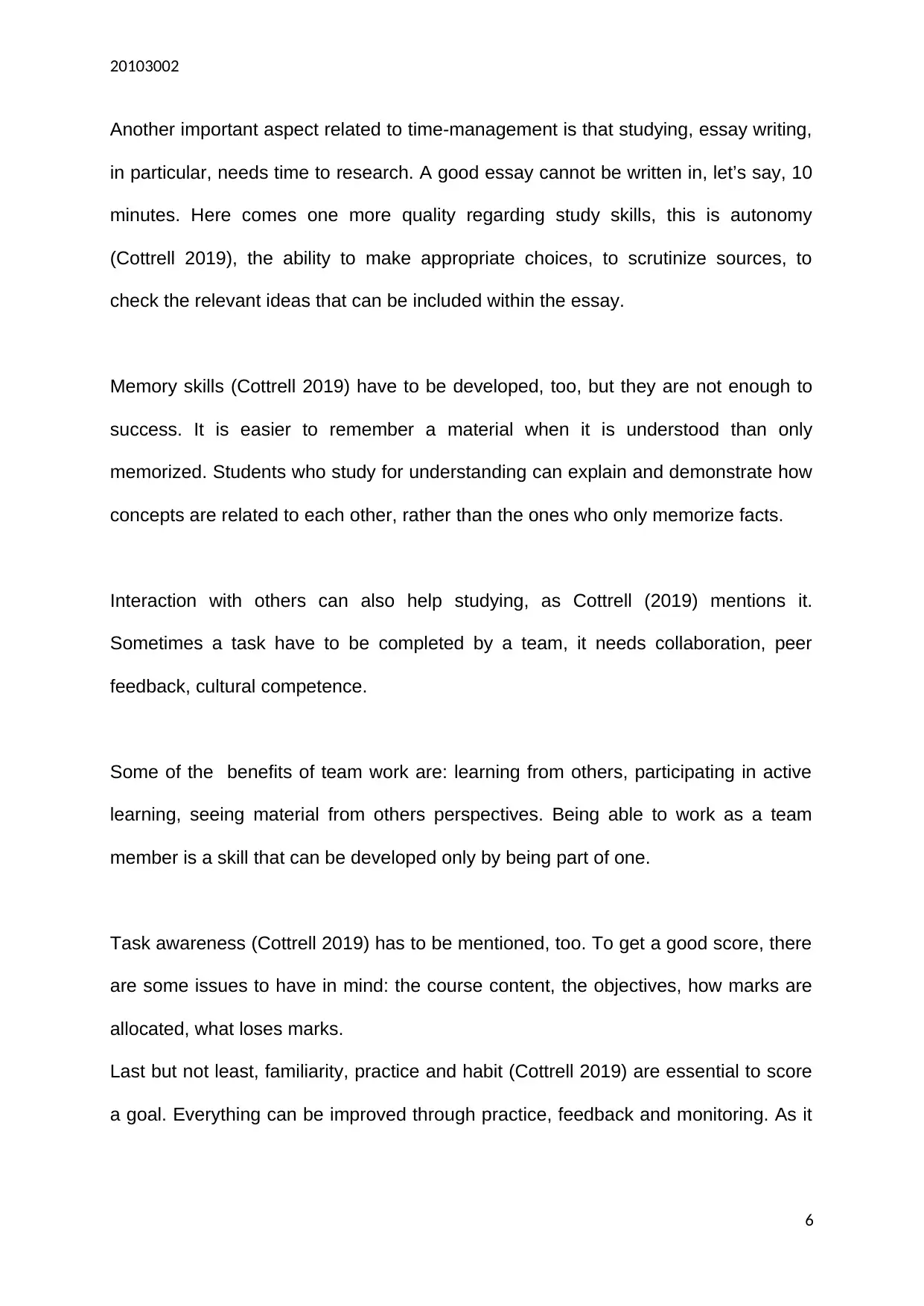
20103002
Another important aspect related to time-management is that studying, essay writing,
in particular, needs time to research. A good essay cannot be written in, let’s say, 10
minutes. Here comes one more quality regarding study skills, this is autonomy
(Cottrell 2019), the ability to make appropriate choices, to scrutinize sources, to
check the relevant ideas that can be included within the essay.
Memory skills (Cottrell 2019) have to be developed, too, but they are not enough to
success. It is easier to remember a material when it is understood than only
memorized. Students who study for understanding can explain and demonstrate how
concepts are related to each other, rather than the ones who only memorize facts.
Interaction with others can also help studying, as Cottrell (2019) mentions it.
Sometimes a task have to be completed by a team, it needs collaboration, peer
feedback, cultural competence.
Some of the benefits of team work are: learning from others, participating in active
learning, seeing material from others perspectives. Being able to work as a team
member is a skill that can be developed only by being part of one.
Task awareness (Cottrell 2019) has to be mentioned, too. To get a good score, there
are some issues to have in mind: the course content, the objectives, how marks are
allocated, what loses marks.
Last but not least, familiarity, practice and habit (Cottrell 2019) are essential to score
a goal. Everything can be improved through practice, feedback and monitoring. As it
6
Another important aspect related to time-management is that studying, essay writing,
in particular, needs time to research. A good essay cannot be written in, let’s say, 10
minutes. Here comes one more quality regarding study skills, this is autonomy
(Cottrell 2019), the ability to make appropriate choices, to scrutinize sources, to
check the relevant ideas that can be included within the essay.
Memory skills (Cottrell 2019) have to be developed, too, but they are not enough to
success. It is easier to remember a material when it is understood than only
memorized. Students who study for understanding can explain and demonstrate how
concepts are related to each other, rather than the ones who only memorize facts.
Interaction with others can also help studying, as Cottrell (2019) mentions it.
Sometimes a task have to be completed by a team, it needs collaboration, peer
feedback, cultural competence.
Some of the benefits of team work are: learning from others, participating in active
learning, seeing material from others perspectives. Being able to work as a team
member is a skill that can be developed only by being part of one.
Task awareness (Cottrell 2019) has to be mentioned, too. To get a good score, there
are some issues to have in mind: the course content, the objectives, how marks are
allocated, what loses marks.
Last but not least, familiarity, practice and habit (Cottrell 2019) are essential to score
a goal. Everything can be improved through practice, feedback and monitoring. As it
6
⊘ This is a preview!⊘
Do you want full access?
Subscribe today to unlock all pages.

Trusted by 1+ million students worldwide

20103002
is said, “repetition is the mother of all learning”, practice is the way to stay focused
longer, to perform skills automatically.
In conclusion, it would appear that just one skill is not enough to succeed, everyone
needs to combine them and one cannot work without the other.
References
Stella Cottrell 2019, The Study Skills Handbook, 5th edition, Red Globe Press
https://www.educationcorner.com/effective-time-management.html
https://www.skillsyouneed.com/learn/sources-info.html
https://dus.psu.edu/academicsuccess/studyskills.html#understanding
7
is said, “repetition is the mother of all learning”, practice is the way to stay focused
longer, to perform skills automatically.
In conclusion, it would appear that just one skill is not enough to succeed, everyone
needs to combine them and one cannot work without the other.
References
Stella Cottrell 2019, The Study Skills Handbook, 5th edition, Red Globe Press
https://www.educationcorner.com/effective-time-management.html
https://www.skillsyouneed.com/learn/sources-info.html
https://dus.psu.edu/academicsuccess/studyskills.html#understanding
7
Paraphrase This Document
Need a fresh take? Get an instant paraphrase of this document with our AI Paraphraser
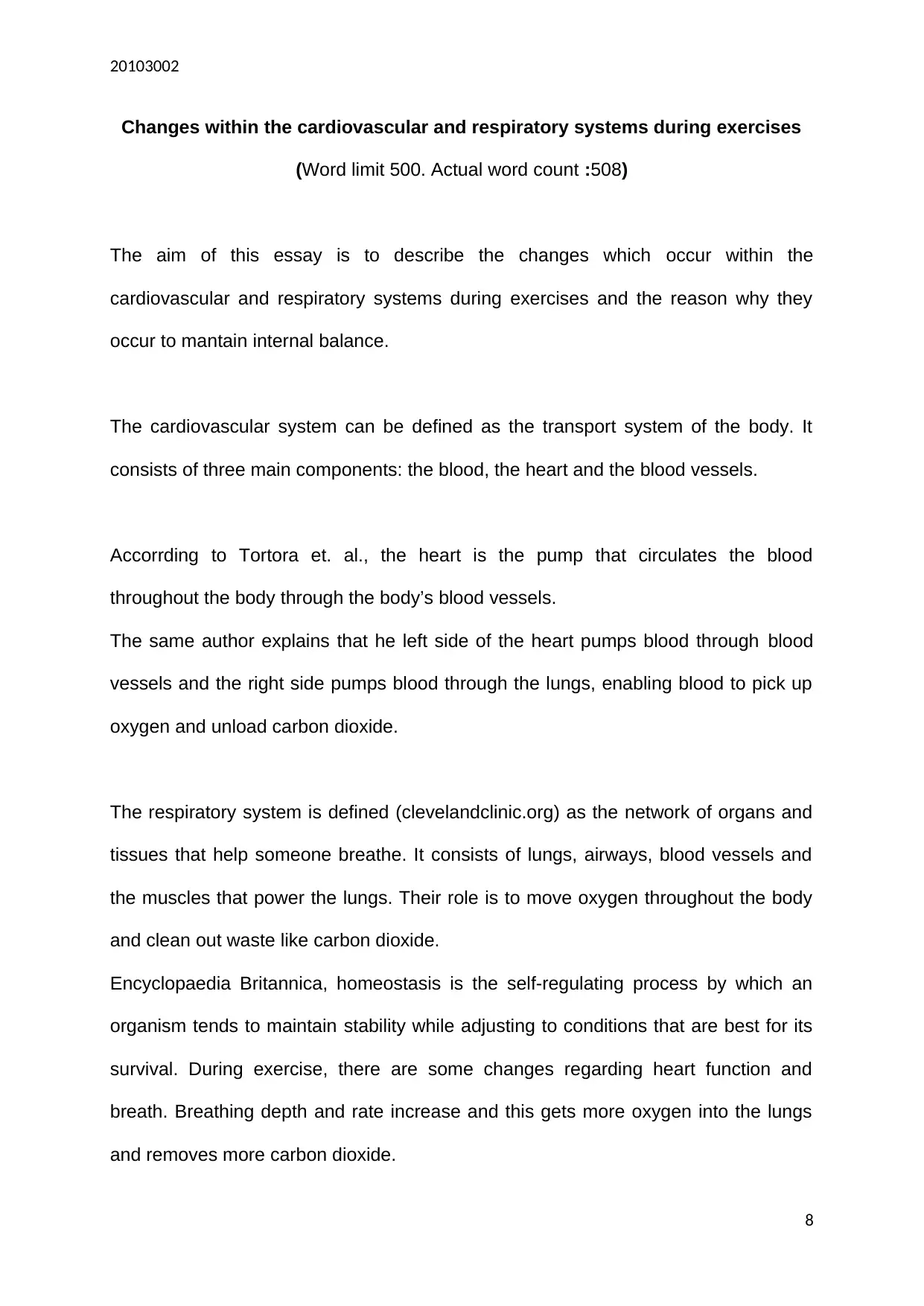
20103002
Changes within the cardiovascular and respiratory systems during exercises
(Word limit 500. Actual word count :508)
The aim of this essay is to describe the changes which occur within the
cardiovascular and respiratory systems during exercises and the reason why they
occur to mantain internal balance.
The cardiovascular system can be defined as the transport system of the body. It
consists of three main components: the blood, the heart and the blood vessels.
Accorrding to Tortora et. al., the heart is the pump that circulates the blood
throughout the body through the body’s blood vessels.
The same author explains that he left side of the heart pumps blood through blood
vessels and the right side pumps blood through the lungs, enabling blood to pick up
oxygen and unload carbon dioxide.
The respiratory system is defined (clevelandclinic.org) as the network of organs and
tissues that help someone breathe. It consists of lungs, airways, blood vessels and
the muscles that power the lungs. Their role is to move oxygen throughout the body
and clean out waste like carbon dioxide.
Encyclopaedia Britannica, homeostasis is the self-regulating process by which an
organism tends to maintain stability while adjusting to conditions that are best for its
survival. During exercise, there are some changes regarding heart function and
breath. Breathing depth and rate increase and this gets more oxygen into the lungs
and removes more carbon dioxide.
8
Changes within the cardiovascular and respiratory systems during exercises
(Word limit 500. Actual word count :508)
The aim of this essay is to describe the changes which occur within the
cardiovascular and respiratory systems during exercises and the reason why they
occur to mantain internal balance.
The cardiovascular system can be defined as the transport system of the body. It
consists of three main components: the blood, the heart and the blood vessels.
Accorrding to Tortora et. al., the heart is the pump that circulates the blood
throughout the body through the body’s blood vessels.
The same author explains that he left side of the heart pumps blood through blood
vessels and the right side pumps blood through the lungs, enabling blood to pick up
oxygen and unload carbon dioxide.
The respiratory system is defined (clevelandclinic.org) as the network of organs and
tissues that help someone breathe. It consists of lungs, airways, blood vessels and
the muscles that power the lungs. Their role is to move oxygen throughout the body
and clean out waste like carbon dioxide.
Encyclopaedia Britannica, homeostasis is the self-regulating process by which an
organism tends to maintain stability while adjusting to conditions that are best for its
survival. During exercise, there are some changes regarding heart function and
breath. Breathing depth and rate increase and this gets more oxygen into the lungs
and removes more carbon dioxide.
8
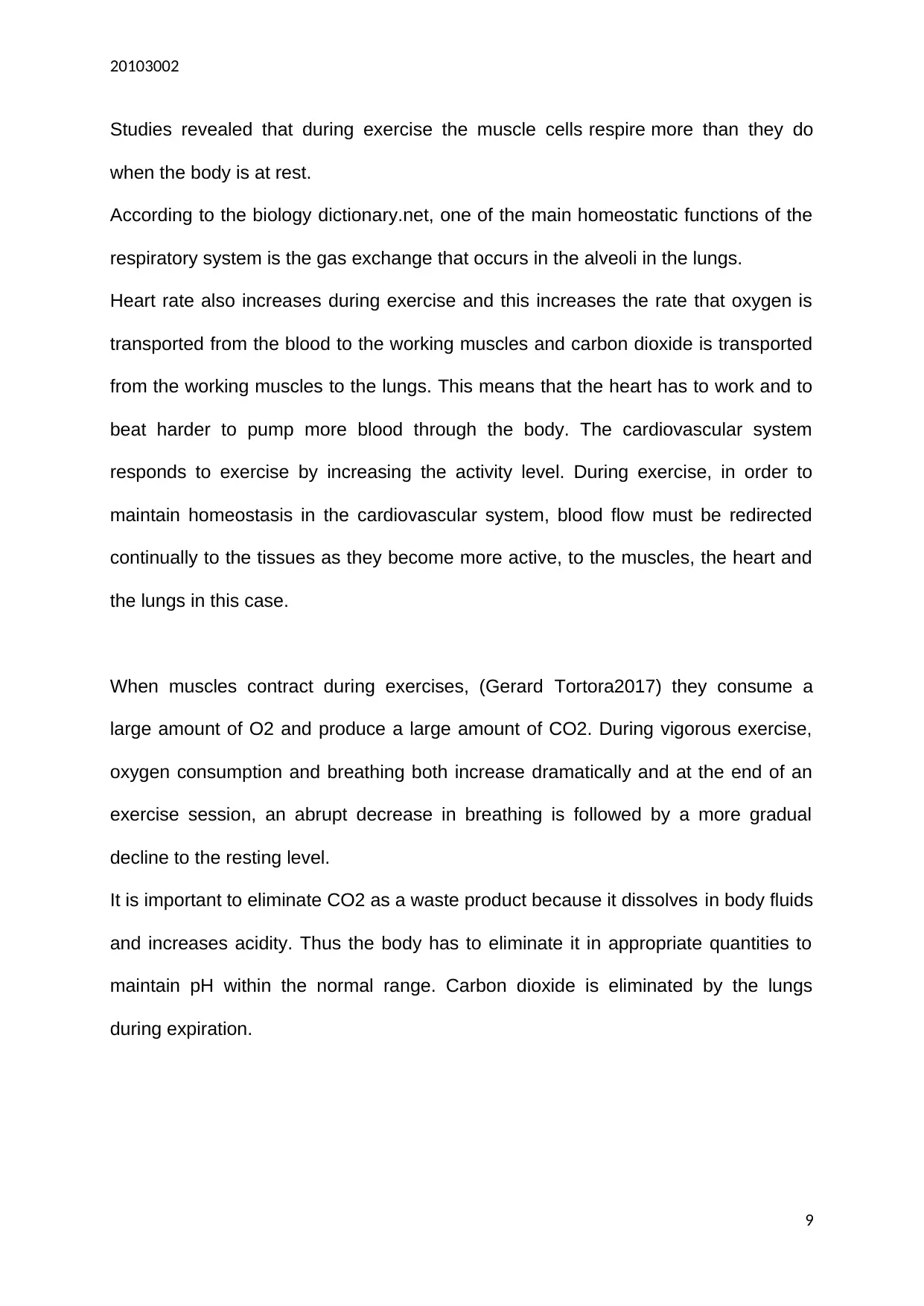
20103002
Studies revealed that during exercise the muscle cells respire more than they do
when the body is at rest.
According to the biology dictionary.net, one of the main homeostatic functions of the
respiratory system is the gas exchange that occurs in the alveoli in the lungs.
Heart rate also increases during exercise and this increases the rate that oxygen is
transported from the blood to the working muscles and carbon dioxide is transported
from the working muscles to the lungs. This means that the heart has to work and to
beat harder to pump more blood through the body. The cardiovascular system
responds to exercise by increasing the activity level. During exercise, in order to
maintain homeostasis in the cardiovascular system, blood flow must be redirected
continually to the tissues as they become more active, to the muscles, the heart and
the lungs in this case.
When muscles contract during exercises, (Gerard Tortora2017) they consume a
large amount of O2 and produce a large amount of CO2. During vigorous exercise,
oxygen consumption and breathing both increase dramatically and at the end of an
exercise session, an abrupt decrease in breathing is followed by a more gradual
decline to the resting level.
It is important to eliminate CO2 as a waste product because it dissolves in body fluids
and increases acidity. Thus the body has to eliminate it in appropriate quantities to
maintain pH within the normal range. Carbon dioxide is eliminated by the lungs
during expiration.
9
Studies revealed that during exercise the muscle cells respire more than they do
when the body is at rest.
According to the biology dictionary.net, one of the main homeostatic functions of the
respiratory system is the gas exchange that occurs in the alveoli in the lungs.
Heart rate also increases during exercise and this increases the rate that oxygen is
transported from the blood to the working muscles and carbon dioxide is transported
from the working muscles to the lungs. This means that the heart has to work and to
beat harder to pump more blood through the body. The cardiovascular system
responds to exercise by increasing the activity level. During exercise, in order to
maintain homeostasis in the cardiovascular system, blood flow must be redirected
continually to the tissues as they become more active, to the muscles, the heart and
the lungs in this case.
When muscles contract during exercises, (Gerard Tortora2017) they consume a
large amount of O2 and produce a large amount of CO2. During vigorous exercise,
oxygen consumption and breathing both increase dramatically and at the end of an
exercise session, an abrupt decrease in breathing is followed by a more gradual
decline to the resting level.
It is important to eliminate CO2 as a waste product because it dissolves in body fluids
and increases acidity. Thus the body has to eliminate it in appropriate quantities to
maintain pH within the normal range. Carbon dioxide is eliminated by the lungs
during expiration.
9
⊘ This is a preview!⊘
Do you want full access?
Subscribe today to unlock all pages.

Trusted by 1+ million students worldwide
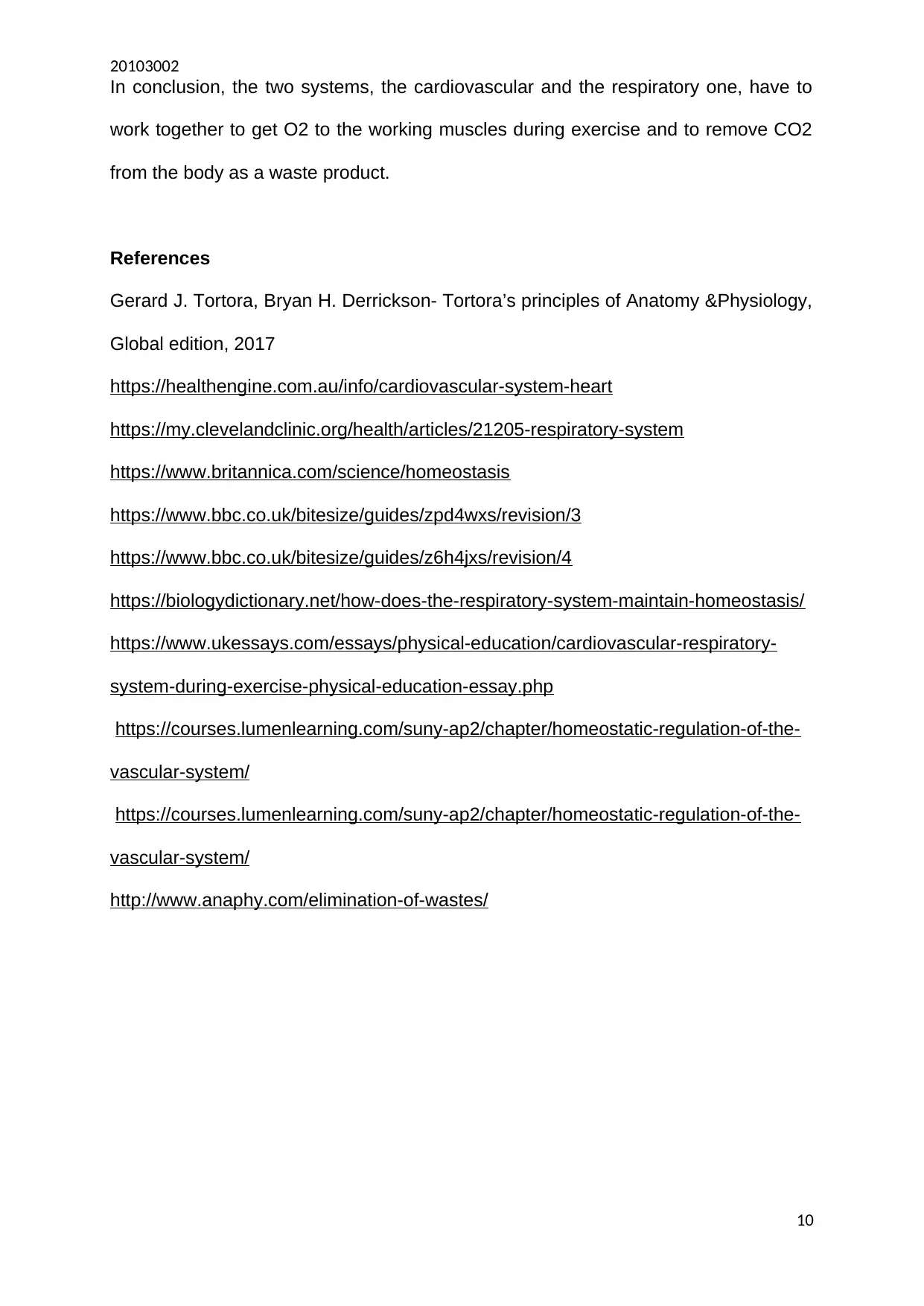
20103002
In conclusion, the two systems, the cardiovascular and the respiratory one, have to
work together to get O2 to the working muscles during exercise and to remove CO2
from the body as a waste product.
References
Gerard J. Tortora, Bryan H. Derrickson- Tortora’s principles of Anatomy &Physiology,
Global edition, 2017
https://healthengine.com.au/info/cardiovascular-system-heart
https://my.clevelandclinic.org/health/articles/21205-respiratory-system
https://www.britannica.com/science/homeostasis
https://www.bbc.co.uk/bitesize/guides/zpd4wxs/revision/3
https://www.bbc.co.uk/bitesize/guides/z6h4jxs/revision/4
https://biologydictionary.net/how-does-the-respiratory-system-maintain-homeostasis/
https://www.ukessays.com/essays/physical-education/cardiovascular-respiratory-
system-during-exercise-physical-education-essay.php
https://courses.lumenlearning.com/suny-ap2/chapter/homeostatic-regulation-of-the-
vascular-system/
https://courses.lumenlearning.com/suny-ap2/chapter/homeostatic-regulation-of-the-
vascular-system/
http://www.anaphy.com/elimination-of-wastes/
10
In conclusion, the two systems, the cardiovascular and the respiratory one, have to
work together to get O2 to the working muscles during exercise and to remove CO2
from the body as a waste product.
References
Gerard J. Tortora, Bryan H. Derrickson- Tortora’s principles of Anatomy &Physiology,
Global edition, 2017
https://healthengine.com.au/info/cardiovascular-system-heart
https://my.clevelandclinic.org/health/articles/21205-respiratory-system
https://www.britannica.com/science/homeostasis
https://www.bbc.co.uk/bitesize/guides/zpd4wxs/revision/3
https://www.bbc.co.uk/bitesize/guides/z6h4jxs/revision/4
https://biologydictionary.net/how-does-the-respiratory-system-maintain-homeostasis/
https://www.ukessays.com/essays/physical-education/cardiovascular-respiratory-
system-during-exercise-physical-education-essay.php
https://courses.lumenlearning.com/suny-ap2/chapter/homeostatic-regulation-of-the-
vascular-system/
https://courses.lumenlearning.com/suny-ap2/chapter/homeostatic-regulation-of-the-
vascular-system/
http://www.anaphy.com/elimination-of-wastes/
10
Paraphrase This Document
Need a fresh take? Get an instant paraphrase of this document with our AI Paraphraser
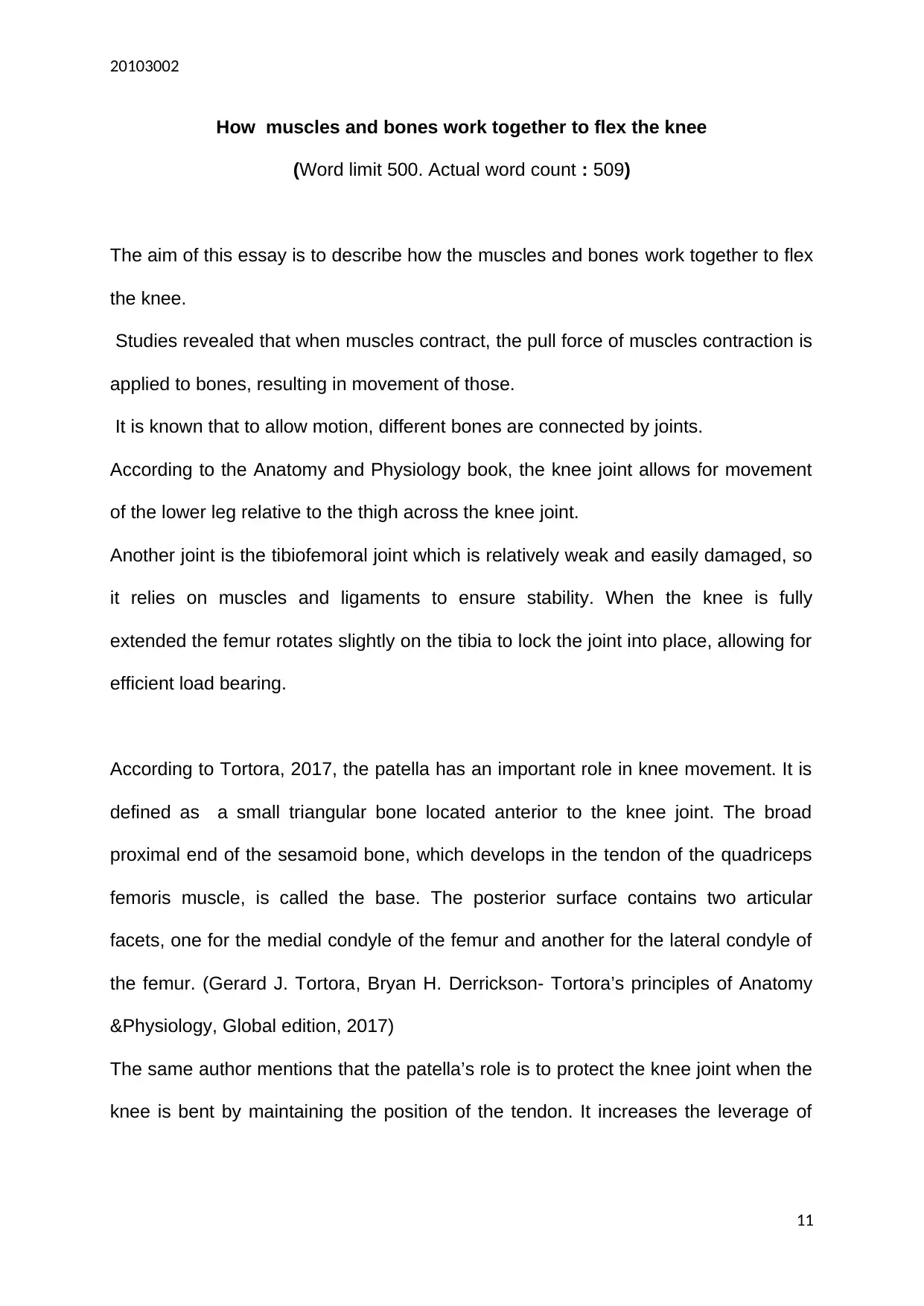
20103002
How muscles and bones work together to flex the knee
(Word limit 500. Actual word count : 509)
The aim of this essay is to describe how the muscles and bones work together to flex
the knee.
Studies revealed that when muscles contract, the pull force of muscles contraction is
applied to bones, resulting in movement of those.
It is known that to allow motion, different bones are connected by joints.
According to the Anatomy and Physiology book, the knee joint allows for movement
of the lower leg relative to the thigh across the knee joint.
Another joint is the tibiofemoral joint which is relatively weak and easily damaged, so
it relies on muscles and ligaments to ensure stability. When the knee is fully
extended the femur rotates slightly on the tibia to lock the joint into place, allowing for
efficient load bearing.
According to Tortora, 2017, the patella has an important role in knee movement. It is
defined as a small triangular bone located anterior to the knee joint. The broad
proximal end of the sesamoid bone, which develops in the tendon of the quadriceps
femoris muscle, is called the base. The posterior surface contains two articular
facets, one for the medial condyle of the femur and another for the lateral condyle of
the femur. (Gerard J. Tortora, Bryan H. Derrickson- Tortora’s principles of Anatomy
&Physiology, Global edition, 2017)
The same author mentions that the patella’s role is to protect the knee joint when the
knee is bent by maintaining the position of the tendon. It increases the leverage of
11
How muscles and bones work together to flex the knee
(Word limit 500. Actual word count : 509)
The aim of this essay is to describe how the muscles and bones work together to flex
the knee.
Studies revealed that when muscles contract, the pull force of muscles contraction is
applied to bones, resulting in movement of those.
It is known that to allow motion, different bones are connected by joints.
According to the Anatomy and Physiology book, the knee joint allows for movement
of the lower leg relative to the thigh across the knee joint.
Another joint is the tibiofemoral joint which is relatively weak and easily damaged, so
it relies on muscles and ligaments to ensure stability. When the knee is fully
extended the femur rotates slightly on the tibia to lock the joint into place, allowing for
efficient load bearing.
According to Tortora, 2017, the patella has an important role in knee movement. It is
defined as a small triangular bone located anterior to the knee joint. The broad
proximal end of the sesamoid bone, which develops in the tendon of the quadriceps
femoris muscle, is called the base. The posterior surface contains two articular
facets, one for the medial condyle of the femur and another for the lateral condyle of
the femur. (Gerard J. Tortora, Bryan H. Derrickson- Tortora’s principles of Anatomy
&Physiology, Global edition, 2017)
The same author mentions that the patella’s role is to protect the knee joint when the
knee is bent by maintaining the position of the tendon. It increases the leverage of
11

20103002
the tendon of the quadriceps femoris muscle. (Gerard J. Tortora, Bryan H.
Derrickson- Tortora’s principles of Anatomy &Physiology, Global edition, 2017)
Muscles that generate movement across the knee are located in the thigh and can be
split into anterior and posterior compartments, as it is mentioned in the Anatomy and
Physiology Book.
There are four muscles in the anterior region of the thigh: Sartorius, quadriceps
femoris, pectineus and ilopsoas.
The sartorius is a thin muscle which helps flexing the lower leg at the knee joint. It si
the body’s longest muscle and it originates from the pelvis and attaches to the tibia.
The quadriceps femoris is composed of four muscles that comprise the front of the
thigh, They stabilize and protect the patella and extend the lower leg at the knee
joint.
Regarding the posterior compartment of the thigh, there can be found three muscles:
the biceps femoris and two synergistic muscles which extend and laterally rotate the
hip. Their main action is flexing of the lower leg at the knee.
Another muscle which helps flex the knee is the popliteus. It is located behind the
knee joint and it rotates laterally the femur on the tibia unlocking the knee joint so that
flexion can occur.
As a conclusion, it can be mentioned that muscles and bones work together to flex
the knee as follows: When the leg is straightened, the quadriceps muscles pull on the
quadriceps tendon, this pulls the kneecap to make the knee extend. When the knee
is bended, the hamstring muscles contract and pull the tibia backwards, causing the
knee to flex.
References
12
the tendon of the quadriceps femoris muscle. (Gerard J. Tortora, Bryan H.
Derrickson- Tortora’s principles of Anatomy &Physiology, Global edition, 2017)
Muscles that generate movement across the knee are located in the thigh and can be
split into anterior and posterior compartments, as it is mentioned in the Anatomy and
Physiology Book.
There are four muscles in the anterior region of the thigh: Sartorius, quadriceps
femoris, pectineus and ilopsoas.
The sartorius is a thin muscle which helps flexing the lower leg at the knee joint. It si
the body’s longest muscle and it originates from the pelvis and attaches to the tibia.
The quadriceps femoris is composed of four muscles that comprise the front of the
thigh, They stabilize and protect the patella and extend the lower leg at the knee
joint.
Regarding the posterior compartment of the thigh, there can be found three muscles:
the biceps femoris and two synergistic muscles which extend and laterally rotate the
hip. Their main action is flexing of the lower leg at the knee.
Another muscle which helps flex the knee is the popliteus. It is located behind the
knee joint and it rotates laterally the femur on the tibia unlocking the knee joint so that
flexion can occur.
As a conclusion, it can be mentioned that muscles and bones work together to flex
the knee as follows: When the leg is straightened, the quadriceps muscles pull on the
quadriceps tendon, this pulls the kneecap to make the knee extend. When the knee
is bended, the hamstring muscles contract and pull the tibia backwards, causing the
knee to flex.
References
12
⊘ This is a preview!⊘
Do you want full access?
Subscribe today to unlock all pages.

Trusted by 1+ million students worldwide
1 out of 27
Your All-in-One AI-Powered Toolkit for Academic Success.
+13062052269
info@desklib.com
Available 24*7 on WhatsApp / Email
![[object Object]](/_next/static/media/star-bottom.7253800d.svg)
Unlock your academic potential
Copyright © 2020–2025 A2Z Services. All Rights Reserved. Developed and managed by ZUCOL.

